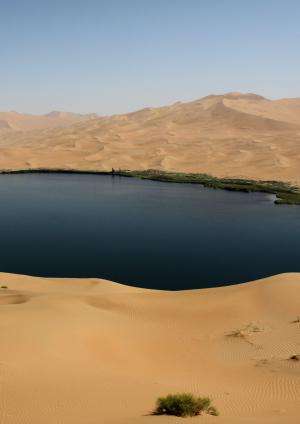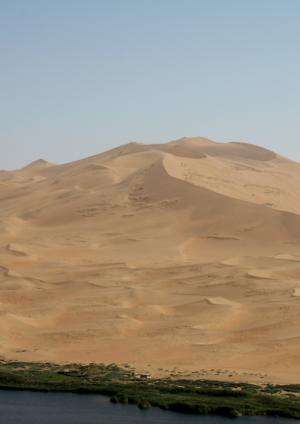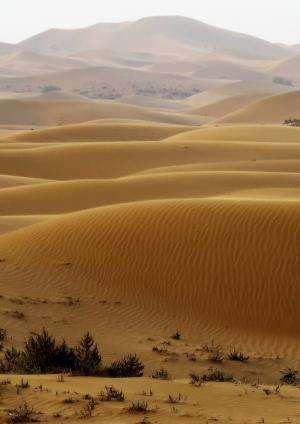Giant dune with superimposed bedform near a lake of the Badain Jaran Desert (Inner Mongolia, China). Credit: Clément Narteau
(Phys.org) —A team made up of members from research facilities in France and China has found that theoretical models built to describe sand dune formation align very closely with how they actually form in nature. In their paper published in Nature Geoscience, the team describes how they bulldozed a section of desert and then watched as sand dunes formed over a three and a half year period.
Understanding how sand dunes form is difficult—trying to replicate the process in a lab grows unwieldy and models created using computers are difficult to prove correct. For that reason, little is known about how sand dunes actually form—finding out is important for both historical purposes here on Earth, and for better understanding atmospheric conditions on other planets.
To gain a better perspective on how sand dunes form the research team used a bulldozer to flatten three separate parcels of sand covered desert land in Inner Mongolia—one parcel was open allowing wind carried sand to enter, another was not, and the third was covered in gravel. The team set up cameras to record the action as nature took over forming new dunes.
In the part of the desert under study, the team noted that the wind comes primarily from two different directions during different times of the year—sometimes from the west, sometimes from the southeast. The team was curious as to how the differing periods of wind, both of which carried sand, would influence dune formation.
Giant dune with superimposed bedform near a lake of the Badain Jaran Desert (Inner Mongolia, China). Credit: Clément Narteau
As the team watched over the course of three and a half years, the dunes constantly shifted directional alignment during the early parts of the study, creating dunes that aligned with the wind—moving back and forth as the winds shifted. But as the dunes grew bigger, the team noticed that they began holding onto some of their shape even as the wind shifted. The result was large dune formation alignment that was a result of the average of the two wind directions—in this case, 50 degrees.
Incipient oblique dunes after 5 years of the landscape scale experiment in the Tengger Desert (Inner Mongolia,China). Credit: Clément Narteau
In comparing the results of real dune formation with those created on a computer before carrying out their field test, the researchers found a very close match, suggesting theory has been correct all along. More research will have to be done of course on different kinds of dunes, but thus far it appears that computer models created for use in the study of dunes on distant planets are likely very accurate.
More information: Emergence of oblique dunes in a landscape-scale experiment, Nature Geoscience (2014) DOI: 10.1038/ngeo2047
Abstract
Aeolian dunes in many arid environments on Earth are shaped by seasonally varying bimodal wind regimes. However, the dynamics of dune evolution under such wind regimes are difficult to investigate at the time and length scales of laboratory experiments1. These bedforms, in their natural environments2, 3, 4, may also be influenced by unknown initial conditions and a variety of factors such as sediment availability5, vegetation6 and cohesion7. Here we report results from a landscape-scale experiment in which we examine the evolution of bedforms under asymmetric bimodal winds. After flattening an experimental dunefield across 16 hectares of the Tengger Desert in Inner Mongolia, we measured winds and topography from March 2008 to October 2011 to reveal the development of regular dune patterns with a constant wavelength and increasing amplitude. On a seasonal timescale, we show that individual dunes propagate in different directions according to the prevailing wind. We find that the orientation of dune crests is controlled by the combination of the normal contributions of the two dominant winds, with respect to their relative strengths and directions, such that crests form an oblique angle of 50° with the resultant sand flux. Our landscape-scale experiment suggests that the alignment of aeolian dunes can be used to determine wind forcing patterns on the Earth and other planetary bodies.
Journal information: Nature Geoscience
© 2014 Phys.org

























